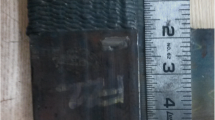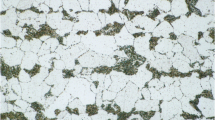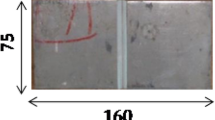Abstract
Dissimilar metal weld overlays (DMWOL) of nickel base alloys on low alloy steel components are commonly used in the oil and gas, petrochemical, and power generation industries to provide corrosion and oxidation resistance in a wide range of service environments and temperatures. Traditionally, dissimilar weld overlays are produced using cold or hot wire gas tungsten arc welding. This study aims to identify and evaluate potential advantages of low heat input gas metal arc welding processes over the conventional gas tungsten arc welding in the production of dissimilar weld overlays. In order to evaluate the quality of these overlays regarding resistance against hydrogen-assisted cracking, their transition zone region is investigated in this part of the publication series. Metallurgical characterization, including energy-dispersive x-ray spectroscopy, is performed on Alloy 625/grade 22 steel overlays. The transition zone is characterized by a narrow planar growth zone and steep compositional gradients from the fusion boundary towards the weld metal. Evidence of low carbon contents in the planar growth zone, as well as for carbide precipitation in the cellular growth zone was found. The microstructure in the transition zone region of the fusion zone shows characteristics known to be suitable for good resistance against hydrogen embrittlement.









Similar content being viewed by others
References
Dodge, M. F., Dong, H. B., Milititsky, M., Barnett, R. P., Marques, V. F. and Gittos, M. F. (2012) ‘Environment-Induced Cracking in Weld Joints in Subsea Oil and Gas Systems- Part I’, in Proceedings of the ASME 31st International Conference on Ocean, Offshore and Arctic Engineering. New York: ASME, pp. 305–313.
Savage, W. F. (1980) Solidification, segregation, and weld imperfections. Welding in the World, 18(5/6):89–114.
Kou, S. (2003) Welding Metallurgy. Second edi. Hoboken, New Jersey: John Wiley & Sons.
NACE (2000) Methods and Controls to Prevent In-Service Environmental Cracking of Carbon Steel Weldments in Corrosive Petroleum Refining Environments, in Standard RP0472-2000 Item No. 21006. Houston, Texas: NACE International.
Gittos, M. F. and Gooch, T. G. (1992) ‘The Interface below Stainless Steel and Nickel-Alloy Claddings’, Welding Journal, 12, pp. 461–472. Available at: http://www.americanweldingsociety.org/wj/supplement/WJ_1992_12_s461.pdf.
Alexandrov, B. T., Lippold, J. C., Sowards, J. W., Hope, A. T. and Saltzmann, D. R. (2013) ‘Fusion boundary microstructure evolution associated with embrittlement of Ni-base alloy overlays applied to carbon steel’, Welding in the World, 57(1), pp. 39–53. https://doi.org/10.1007/s40194-012-0007-1.
Alexandrov, B. T., Shi, S., Rodelas, J. M. and Lippold, J. C. (2012) ‘A New Test for Evaluation of Susceptibility to Hydrogen Assisted Cracking in Dissimilar Metal Welds’, in Corrosion 2012. Salt Lake City, Utah: NACE International. https://doi.org/10.1017/CBO9781107415324.004.
Beaugrand, V. C. M., Smith, L. S. and Gittos, M. F. (2009) ‘Hydrogen embrittlement of 8630M/625 subsea dissimilar joints: Factors that influence the performance’, in Proceedings of the 28th International Conference on Ocean, Offshore and Arctic Engineering. Great Abington, Cambridge, UK: TWI Ltd., pp. 227–236. https://doi.org/10.1115/OMAE2009-80030.
Rozmus-Górnikowska, M., Blicharski, M. and Kusiński, J. (2014) ‘Influence of weld overlaying methods on microstructure and chemical composition of Inconel 625 boiler pipe coatings’, Kovove Materialy, 52, pp. 1–7. https://doi.org/10.4149/km20143141.
Bourgeois, D. (2015) Hydrogen Assisted Crack in Dissimilar Metal Welds for Subsea Service under Cathodic Protection, Thesis (Ph.D.). The Ohio State University. Available at: http://adsabs.harvard.edu/abs/2015PhDT.......191B.
Frei, J., Alexandrov, B. T. and Rethmeier, M. (2016) ‘Low heat input gas metal arc welding for dissimilar metal weld overlays part I: the heat-affected zone’, Welding in the World, 60(3), pp. 459–473. https://doi.org/10.1007/s40194-016-0306-z.
Daniels, T. W. (2015) Applicability of Cold Metal Transfer for Repair of Dissimilar Metal Welds in Stainless Steel Piping in Nuclear Power Plants. OSU. Available at: http://rave.ohiolink.edu/etdc/view?acc_num=osu1429873704.
Sotoudeh, K., Eren, S. E., Gittos, M. F., Milititsky, M., Kabra, S. and Zhang, S. Y. (2013) ‘Evaluation of residual stresses in steel-to-nickel dissimilar joints’, in Proceedings of the ASME 2013 32nd International Conference on Ocean, Offshore and Arctic Engineering. Nantes, France: TWI Ltd. Available at: http://www.twi-global.com/technical-knowledge/published-papers/evaluation-of-residual-stresses-in-steel-to-nickel-dissimilar-joints/.
ASTM (2014) Standard Specification for Forged or Rolled Alloy-Steel Pipe Flanges , Forged Fittings , and Valves and Parts for High-Temperature Service. United States: ASTM International. https://doi.org/10.1520/A0182
Fenske JA, Robertson IM, Ayer R, Hukle M, Lillig D, Newbury B (2012) Microstructure and hydrogen-induced failure mechanisms in Fe and Ni alloy weldments. Metall Mater Trans A Phys Metall Mater Sci 43:3011–3022. https://doi.org/10.1007/s11661-012-1129-1
Fenske JA, Robertson IM, Ayer R, Hukle M, Lillig D, Newbury B (2010) Hydrogen effects on the failure mechanisms in Fe-Ni weldments. Microsc Microanal 16:6–7. https://doi.org/10.1017/S14319276100
DuPont, J. N., Lippold, J. C. and Kiser, S. D. (2009) Welding Metallurgy and Weldabilidy of Nickel Based Alloys. Hoboken, New Jersey: Wiley. Available at: http://onlinelibrary.wiley.com/doi/10.1002/cbdv.200490137/abstract.
Silva, C. C., De Miranda, H. C. and Farias, J. P. (2013) ‘Chemistry and Crystallographic Evaluation of Ni-based Alloy and Steel Dissimilar Interface’, in DebRoy, T., David, S. A., DuPont, J., Koseki, T., and Bhadeshia, H. K. (eds) Proceedings of the 9th International Conference on Trends in Welding Research. ASM International, pp. 344–352.
Rozmus-Górnikowska M, Cieniek Ł, Blicharski M, Kusiński J (2014) Microstructure and microsegregation of an Inconel 625 weld overlay produced on steel pipes by the cold metal transfer technique. Arch Metall Mater 59:2–5. https://doi.org/10.2478/amm-2014-0185
Silva CC, De Miranda HC, Motta MF, Farias JP, Afonso CMR, Ramirez AJ (2013) New insight on the solidification path of an alloy 625 weld overlay. Integr Med Res 2:228–237. https://doi.org/10.1016/j.jmrt.2013.02.008
Acknowledgements
This study was supported by ExxonMobil and Fronius International through provision of materials, welding equipment, and technical support, and was performed at the Welding Engineering Laboratory of the Ohio State University.
Author information
Authors and Affiliations
Corresponding author
Additional information
Recommended for publication by Commission IX - Behavior of Metals Subjected to Welding
Rights and permissions
About this article
Cite this article
Frei, J., Alexandrov, B.T. & Rethmeier, M. Low heat input gas metal arc welding for dissimilar metal weld overlays part II: the transition zone. Weld World 62, 317–324 (2018). https://doi.org/10.1007/s40194-017-0539-5
Received:
Accepted:
Published:
Issue Date:
DOI: https://doi.org/10.1007/s40194-017-0539-5




